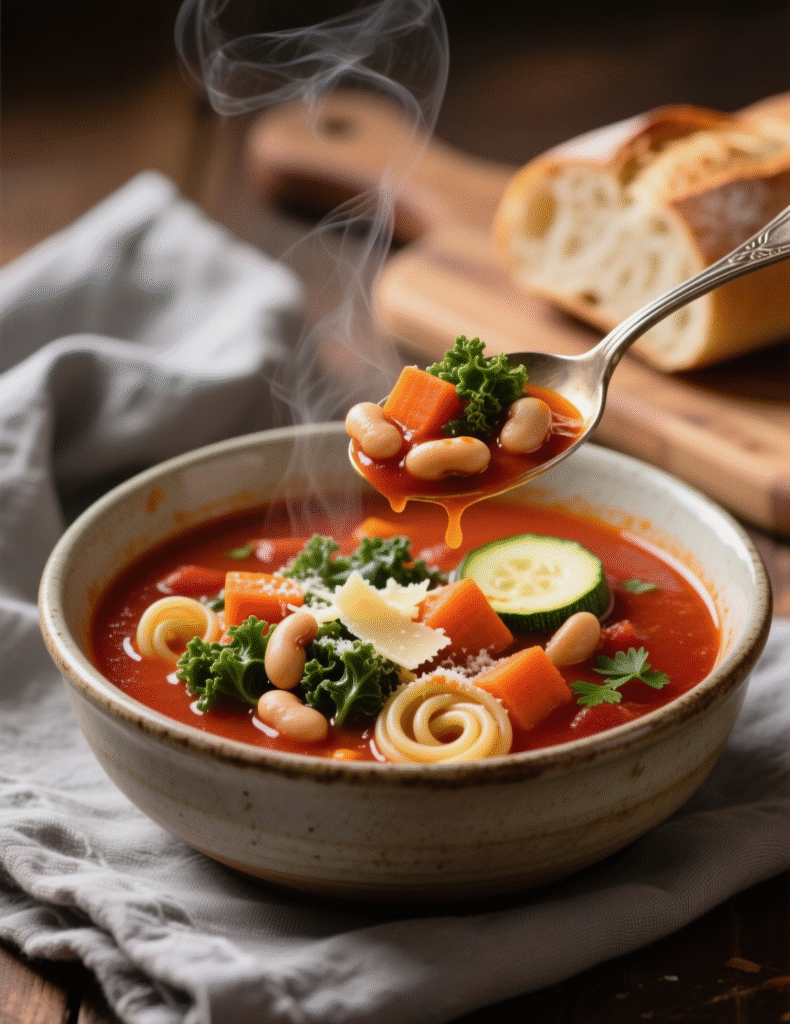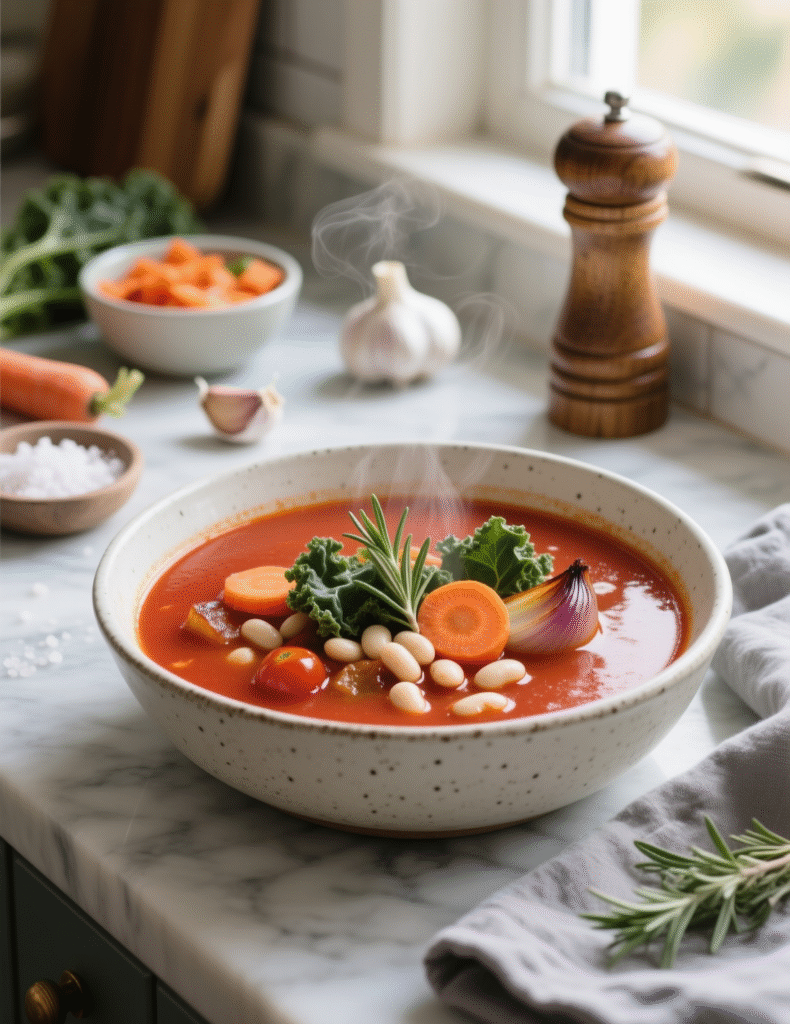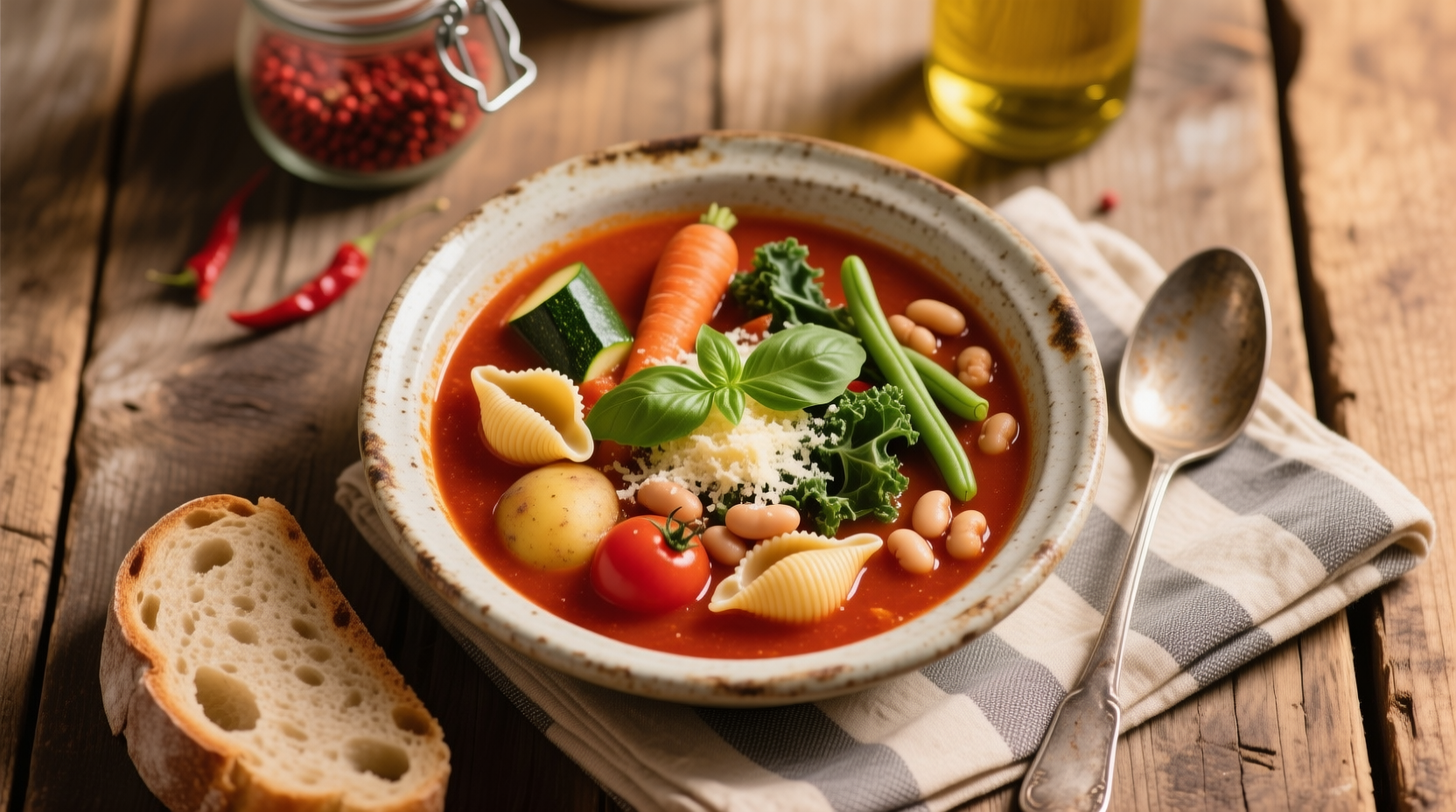The first spoonful catches you off guard.
There’s nothing extravagant in it—no truffle oil, no slow-cooked bone broth, no twelve-hour roux. Just a rich medley of vegetables, herbs, and a whisper of olive oil. But it hits. This is Hearty Italian Vegetable Soup, and if you think it’s just a peasant dish, you’ve already missed the point.
This soup is not just food. It’s survival, history, and craft—boiled down to the essentials. And it still manages to impress the most hardened palates.
Let’s dive deep into what makes this rustic dish a quiet masterpiece. Not in some trendy “clean eating” way. This is about understanding flavor from the ground up, honoring simplicity, and treating each ingredient like it matters (because it does).
What Is Hearty Italian Vegetable Soup?
At its core, it’s a minestra—Italy’s traditional vegetable-based soup, often stretching across regions like Tuscany, Liguria, and Lazio. But don’t confuse it with minestrone, although they share a family tree. Minestrone usually includes pasta or rice. Hearty Italian Vegetable Soup, though, tends to let the vegetables lead the dance.
Now, depending on where you go in Italy, you’ll get different versions.
In Tuscany? You’ll find ribollita, thickened with day-old bread and cannellini beans.
Liguria? Expect more greens, basil, maybe even a touch of pesto stirred in late.
What binds them all is not just ingredients—but intention. The goal isn’t to show off. It’s to nourish. You could say it’s poor man’s food. But poor men knew flavor better than most Michelin chefs today, let’s be honest.
The Heart of the Soup: Vegetables That Actually Matter
You can’t just throw in random chopped veg and expect it to sing. Balance, seasonality, and depth matter.
Here are the base players, no excuses:
- Onions, carrots, and celery (your soffritto)
The holy trinity of Italian cooking. Always start with a low, slow sweat in extra virgin olive oil. - Garlic
Sliced, not minced. You want mellow garlic, not bitterness. - Zucchini
Adds body and natural sweetness. Dice it chunky enough to hold up. - Green beans
Snappy texture. Don’t overcook them into mush—please don’t. - Cabbage or kale
You need the bitterness. It rounds things out. - Tomatoes (crushed or diced)
These give it acidity and umami. Don’t overdo it or it turns into stew. - Potatoes
Yes, they thicken it, yes, they make it hearty. But keep ‘em in moderation or they’ll dominate.
Pro tip? Throw in a Parmesan rind while simmering. It’s like cheating—but allowed.
Now here’s the thing. All these are flexible. But you must respect the balance: sweet, bitter, starchy, bright. Tilt it too much in one direction and it’ll taste like hospital food.

Timing Is Everything: Layering Ingredients Like a Pro
One of the rookie mistakes? Dumping everything in one go. That’s lazy soup-making.
Start with the aromatics (onion, garlic, carrot, celery). Sweat them low and slow. Give it 10–12 minutes. Not 5. Not “until translucent.” Wait until the edges brown just a tiny bit.
Then the tomatoes. Let them cook down until the acidity mellows—another 8 minutes or so.
Then go in with the harder veg—potatoes, green beans.
Greens and zucchini? Way later. Maybe even the last 10 minutes. If you cook them too long, you lose their bite.
Final 5 minutes? That’s when you taste and fix it. Salt, pepper, maybe a swirl of olive oil or even a pinch of red pepper flakes. Be brave, but not chaotic.
The Broth Debate: Stock or Water?
Here’s where things get chef-y.
Many purists use water—yep, plain ol’ water. Why? Because if your vegetables are fresh and your soffritto is done right, you don’t need anything else.
But if you want to amp up the depth (especially in winter), go for a light vegetable stock. Homemade, preferably. Store-bought works if you dilute it by half.
Avoid meat broths unless you’re okay with the soup losing its vegetal essence. This is not the time for beef stock bravado.
Beans: Optional, But Powerful
Cannellini or borlotti beans are classic additions. They bring creamy texture and a protein boost. Use cooked beans, not raw, unless you’re in it for the long haul.
Here’s a little-known trick: mash a few spoonfuls of the beans into a paste and stir it back in. This thickens the broth naturally and gives it that “been simmering for days” feel.
Some chefs add a spoon of bean puree as a finisher. Cheeky move. Totally worth it.
Don’t Forget the Garnishes: They Make or Break It
This soup’s pretty humble—but don’t skip the garnishes. They make it.
- A good drizzle of peppery olive oil
- Grated Parmesan or Pecorino
- A slice of toasted country bread, rubbed with garlic
- Even a dollop of pesto, if you lean Ligurian
These aren’t extras. They’re essential for the final balance.
Storage? It Only Gets Better (But Not Forever)
Here’s a chef’s secret: this soup tastes better the next day. The flavors meld. The starches bloom. It’s like it finds itself overnight.
But after day 3? It starts to sulk. The greens go muddy. The texture thickens too much. So eat it or freeze it.
And never, ever reboil it. Warm it gently. Think of it like warming up a symphony, not nuking leftovers.
Nutritional Snapshot (Because Even Chefs Check It)
- Low in fat (unless you go wild on the oil)
- High in fiber and antioxidants
- Great for gut health (thanks beans & greens)
- Vegan/vegetarian friendly (unless you add Parm)
According to a 2023 study by the University of Florence, soups rich in cruciferous veg (like kale and cabbage) showed a 22% improvement in digestion markers compared to baseline diets. That’s not nothing.
So yes, it tastes amazing. But it’s also medicine in a bowl.
Common Mistakes? Let’s Set the Record Straight
- Overcooking everything
Mushy soup is sad soup. - Using canned soup stock
Too salty, too flat. Don’t. - Skipping the soffritto
This ain’t a dump-and-boil recipe. - Adding pasta too early
If you do add it, cook it separately and stir in just before serving. Nobody wants pasta-flavored gruel. - Under-salting
Veggie soups need bold seasoning to shine. Taste often. Salt smart.

A Glimpse Into the Italian Home Kitchen
I once cooked in a hillside home in Abruzzo. Middle of nowhere, stone walls, two goats in the yard. The nonna, maybe 78, stirred a pot of soup bigger than her torso. No measurements. No recipe.
She added a crust of bread right into the pot. No garnish. Just warmth. It fed 10 of us. Every spoonful made you feel like you’d lived a better life than you had.
That’s the power of this soup. It’s not about skill. It’s about care.
Emerging Trends: Where Pros Are Taking It
Fine dining chefs are putting spins on this humble dish:
- Fermented vegetables for deeper umami
- Smoked olive oil as a finisher
- Roasted tomato paste instead of canned tomatoes
- Sous vide greens to retain chlorophyll and color
Even Michelin-starred places are plating it in sleek black bowls, garnished with micro basil and a single edible flower. But underneath it all, it’s still the same thing.
A bowl of honesty.
Final Takeaways and Tips for Pro Chefs
- Start slow. Your soffritto builds your entire flavor base.
- Let the soup tell you what it needs. Not the recipe.
- Respect the seasons. Zucchini in winter? That’s a no from me.
- Always finish with something fresh—oil, cheese, herbs.
- Know when to stop. This soup isn’t about perfection. It’s about feeling.
Don’t overthink it. But don’t disrespect it either. Hearty Italian Vegetable Soup deserves your attention, your patience, and maybe even your best ladle.
After all, in a world drowning in fancy foam and fermented seaweed ice cream, sometimes all you need is a bowl of vegetables done just right.
FAQs
What vegetables are essential in Hearty Italian Vegetable Soup?
Onion, carrot, celery, zucchini, green beans, cabbage or kale, potatoes, and tomatoes form the base.
Can I use store-bought broth instead of water?
Yes, but dilute it and avoid strong meat broths to keep the soup’s clean, vegetal flavor.
Is this soup the same as minestrone?
Not exactly—minestrone often includes pasta or rice, while this soup focuses more on just vegetables.
Do I need to use beans?
No, but cannellini or borlotti beans add creaminess and protein, making the soup heartier.
Can I make this soup ahead of time?
Yes, it tastes even better the next day after the flavors meld.
How long does this soup keep in the fridge?
Up to 3 days—after that, the texture and flavor start to degrade.
Can I freeze Italian vegetable soup?
Absolutely, just avoid freezing it with pasta or delicate greens already added.
What’s the best garnish for serving?
Drizzle of olive oil, grated Parmesan, or garlic-rubbed toast elevates it beautifully.
Should I peel the vegetables first?
Peel tougher ones like potatoes and carrots; softer veg like zucchini can go in unpeeled.
Is this soup vegan or vegetarian?
Yes—just skip the Parmesan or use a vegan alternative.

Mariana is a passionate home cook who creates delicious, easy-to-follow recipes for busy people. From energizing breakfasts to satisfying dinners and indulgent desserts, her dishes are designed to fuel both your body and hustle.
When she’s not in the kitchen, she’s exploring new flavors and dreaming up her next recipe to share with the Foodie Hustle community.

